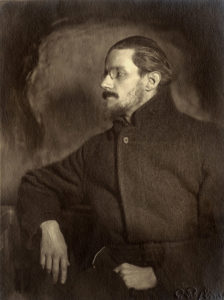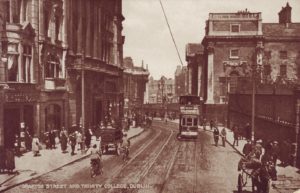James Joyce is regarded by many as one of the most significant writers in the history of the novel. He is most famous for his contributions to a form of prose fiction known as literary modernism; a style of storytelling which emphasises, among other things, a stream of consciousness technique, which allows the reader to quite literally get inside the heads of characters and to experience their world through their own psyches. However, due to the convoluted style that Joyce often employs, he is regularly seen as a rather ‘difficult’ author to get into, one whose work sometimes borders on the incomprehensible. Ulysses, for example, constantly flicks back and forth between first- and third-person narratives, while Finnegans Wake is, let’s be honest, barely written in English.

James Joyce c. 1918
This simply isn’t the case with his first novel, and it is this novel which I consider (perhaps controversially) to be his true masterpiece. The work I’m referring to here is of course Dubliners, first published in 1914. While technically not a novel per se—it’s actually a collection of short stories—Dubliners certainly reads as if it were a singular novel because all the stories within are tightly interwoven and constantly overlap. The clarity of the writing is astonishing: even by today’s standards it often reads as fresh as paint. Throughout, Joyce employs a very straightforward style of narrative which makes use of some brilliant poetic prose and is replete with striking metaphoric imagery. On this basis alone it really is a joy to read.
Each story revolves around a very simple plot. For example, Eveline is about a woman torn between staying in Dublin and fleeing with her lover to Argentina; Two Gallants deals with a pair of criminals in their attempt to steal from a young woman’s employer; whilst Ivy Day in the Committee Room focuses on the failures of Irish nationalist politics in Dublin at the turn of the twentieth century. And in true modernist fashion, each story begins by throwing us straight into the middle of its characters’ environment and circumstances. There’s no messing around with developing the story’s background or context beforehand; instead, both background and context emerge as the story unfolds.
Yet despite the simplicity of the narrative you are always aware that there’s something incredibly complex going on underneath, and this really strikes at the heart of why Dubliners is so masterfully written. The individual fine details contained within the text eventually build up to reveal a strikingly detailed picture of Dublin and its inhabitants during the late nineteenth and early twentieth centuries. Deep-seated religious tensions, economic hardships, social mobility, even the Catholic Church’s implicit acceptance of paedophilia—all of these themes are dealt with, and many more. As you read Dubliners, Dublin becomes your entire world, and the sheer levels of detail you encounter about this city are almost ethnographic in scope. You can pick up this novel feeling like you know nothing about Dublin, and once you’ve finished you can walk away feeling like you know everything there is to know.
On the other hand, in amongst all of this social complexity are characters that are instantly identifiable and which conjure in us a mixture of different feelings and emotions ranging from admiration to downright pity. The character of Maria in the story Clay is that of a woman who is trying her best to be as kind and as helpful to those around her as possible, despite the fact that the circumstances within which she lives are frustrating and monotonous. The old man in the story An Encounter, however, is a character whose sexual promiscuity is so great that at one point he indulges himself in a spot of public masturbation. When referring to the work of Shakespeare, the rapper Akala once said that the power inherent in plays such as Hamlet or Macbeth lies in their ability to portray ways of being human that transcend the time and place within which they were written. I believe that this certainly applies to the work of Joyce as well, and particularly to Dubliners. Whether we like it or not, we can see a little bit of ourselves in each of Joyce’s characters, and as a result they each force us to think about our own human character and the ways that we conduct ourselves.

Grafton Street, Dublin, at the turn of the twentieth century
Overall, Dubliners is one of those ‘classic’ novels that really has stood the test of time and is absolutely still relevant today. I believe the reason that not many people have read this novel is because they’re perhaps put off by the avant-gardism of Joyce’s later work. But I recommend Dubliners to anyone who is a fan of literature, and I think it has the capacity to surprise you, so it’s well worth having a go.
By Rhys Morgan

